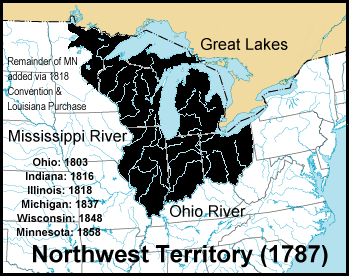THE GREAT LAND ORDINANCES: The Confederation's Major Achievement

Background:
During the American Revolution the Americans resolved not to treat their territories as colonies. Following the war Congress sold millions of acres of land to large companies, but those companies had trouble attracting settlers. Congress therefore realized that some form of control was necessary in the territories that were not yet states.
Thomas Jefferson’s Ordinance of 1784 stated that when a territory had a population equal to that of the smallest state it might apply for admission. Jefferson’s Ordinance also provided for the following:
- Towns in the territory were to be divided into 36 1-square-mile lots of 640 acres, to be sold at $1 per acre.
- Income from one 36th section was to be provided for schools, which reflected Jefferson’s commitment to public education as essential to democracy.
- The Ohio and Scioto land companies were formed; Marietta, Ohio, was established as the first town in the new territory. (Marietta remains proud of that distinction.)
Land Ordinance of 1785 provided details for land surveys and sales, square patterns, 6x6 miles, 36 sections of 640 acres, $1 each minimum, sold at auction. (Speculators were able to take advantage of the law.)
The Northwest Ordinance of 1787
Following the Ordinances of 1784 and 1785, which started the process, in 1787 Congress issued the Northwest Ordinance, which provided government for the area north and west of the Ohio River, the states that now are Ohio, Indiana, Illinois, Michigan and Wisconsin.
Some historians have claimed that the principles established in the Northwest Ordinance are so important that they actually form part of the Constitution. The reason is that the Northwest Ordinance promised a republican form of government for inhabitants of those territories. It guaranteed that residents in the territories of the United States would not be treated as second class citizens, and that when they were eventually admitted as states, they would enter under the same terms as those states that were already part of the union. The principle behind the Northwest Ordinance was carried into the Constitution in Article IV, Section 4, which states: “The United States shall guarantee to every State in this Union a Republican Form of Government.”
The Northwest Ordinance replaced the Land Ordinance of 1784. It provided for territorial governors as well as a territorial secretary and three judges who would be appointed by Congress. It also included a Bill of Rights for the territories that included freedom of worship, trial by jury, freedom of speech habeas corpus and proportional representation. It was also the first national law passed to provide for public education anywhere in the world. The land in the territories was laid out in squares, and in each area a square would be set aside for that purpose.
The ordinance also stated that when a territory reached a population of 60,000 that would be eligible for statehood. As soon as each territory had 5000 free adult males, they were authorized to elect a bicameral legislature. The territory provided for the admission of 3 to 5 states, and they eventually became the states mentioned above: Ohio, Indiana, Illinois, Michigan and Wisconsin. It guaranteed that any new states admitted to the nation would be “on an equal footing” with the old states. There would be no mistreatment of territories in the way that the British had treated her colonies.
Most important, slavery was prohibited in the Northwest Territory. It is considered a tragedy that the anti-slavery provision was not extended to later territories. If so, the only slave states would have been the original 6: Delaware, Maryland, Virginia, North Carolina, South Carolina and Georgia. In the other 7 original states, provisions were already underway for the abolition of slavery, either immediately or over time.
Provisions for Admission to Statehood for New Territories was, aside from winning the war, the greatest achievement of the Confederation. Gradually all western lands were ceded to government and quickly became states. The Indian inhabitants were unfortunately forced to move farther westward.
Text of the Northwest Ordinance
| Sage American History Home | Federal Era Home | Updated May 30, 2020 |